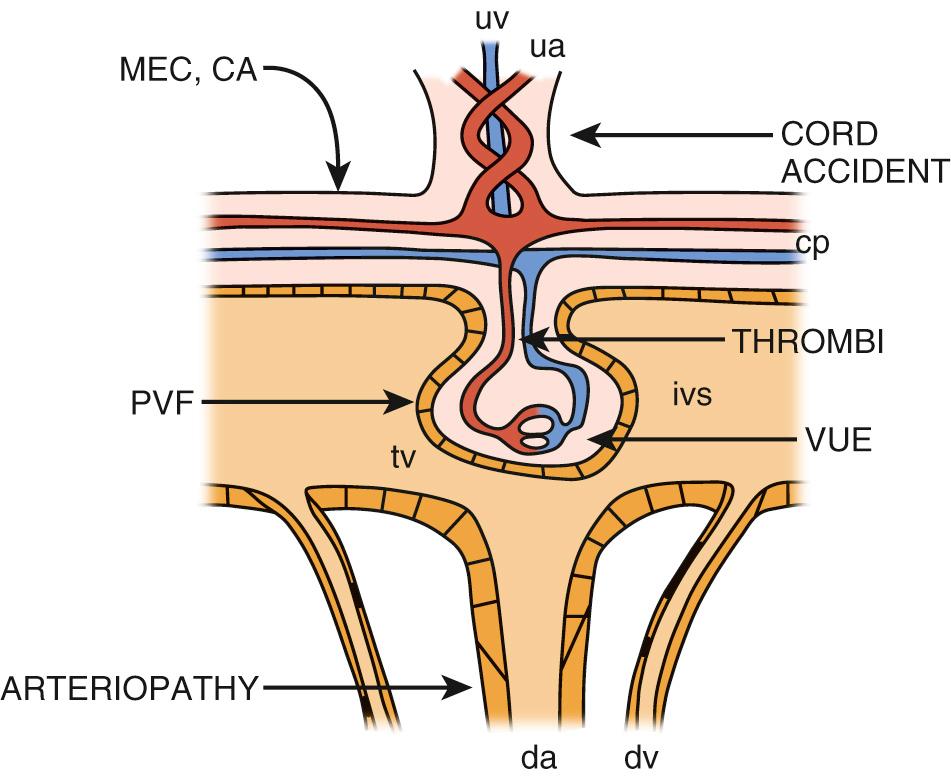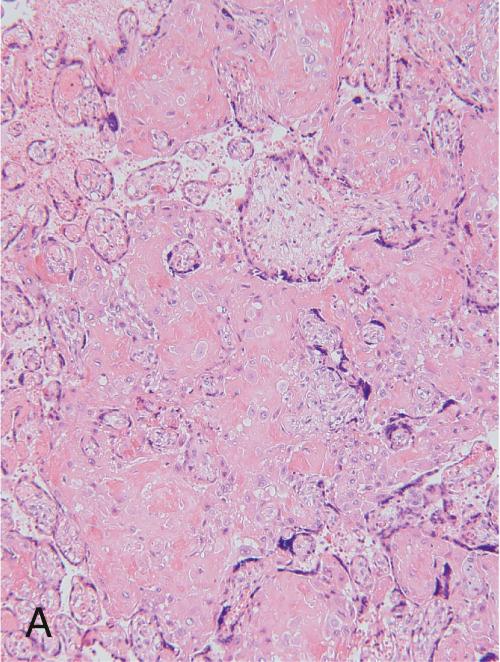Physical Address
304 North Cardinal St.
Dorchester Center, MA 02124
The placenta has two opposing functions. It is the sole source of sustenance for the fetus and its sole protection against noxious external influences. It can be argued that no evaluation of a sick neonate is complete without knowing the status of the organ that has accompanied it through the preceding gestation. The specific “value added” by placental examination can be summarized under five overlapping headings:
Identification of immediately treatable processes: elevated risk of neonatal sepsis (histologic chorioamnionitis with fetal inflammatory response), specific infections (CMV cytomegalovirus, candida, syphilis, listeria), retained placenta, metabolic storage diseases, placental malignancies
Determination of the underlying cause of adverse outcomes: subclassifies preterm delivery, fetal growth restriction, and stillbirth into pathophysiologically homogenous phenotypes
Estimation of recurrence risk: different patterns of placental injury have distinct and widely disparate rates of recurrence varying from 0%-70%
Guidance for future care path(s): screening for predisposing maternal diseases, genetic testing, high-risk referral, enhanced antenatal surveillance, initiation of antenatal therapy, elective early delivery
Quality assurance and risk management: separating perceived from actual pathology (e.g., chorioamnionitis, abruption), uncovering subacute and chronic disorders predisposing to neonatal encephalopathy, seizures, stroke, or cerebral palsy
This chapter is not a comprehensive review of placental pathology; the reader is referred to five general references. Rather, it addresses three topics: (1) the optimal use of the pathology service to obtain useful information; (2) an explanation of specific patterns of placental injury; and (3) clinicopathologic correlation (i.e., which lesions are seen in which clinical situations).
Because not all placentas are submitted to pathology, every obstetric service should have a specific list of situations in which a placental examination is indicated. Box 26.1 provides a list compiled by the College of American Pathologists in collaboration with a panel of neonatologists and obstetricians. Because many sick neonates are transported from other hospitals, there should be a policy to ensure a timely placental examination. The best solution is to bring the placenta along with the neonate to the tertiary care center. For various reasons, the transport of the tissue specimen itself is sometimes impractical. In these cases, the slides and pathology report from the referring hospital should be requested and reviewed by the pathologist at the hospital where the neonate is to be treated. Whenever possible, placentas should be refrigerated immediately after delivery and sent without fixative to the pathology laboratory. Specimens maintained in this fashion remain useful for at least 7 days after delivery. When refrigeration within 1-2 hours of delivery is impossible, placentas should be immersed in 2-3 volumes of formalin; placentas can remain in formalin for an indefinite period before examination by the pathologist.
Indications for Submission (College of American Pathologists Practice Guideline 1997) : Developed by a task force of pathologists, obstetricians, and neonatologists. Indications separated into three groups as listed below.
Delivery at less than 37 weeks or more than 42 weeks (accepted alternative is <34 weeks)
Systemic disorders with concern for mother or infant (hypertension, diabetes, other)
Peripartum fever or infection
Unexplained or excessive third-trimester bleeding
Unexplained or recurrent pregnancy complications
Invasive procedures with suspected placental injury
Thick or viscid meconium
Severe oligohydramnios/polyhydramnios
Stillbirth or neonatal death
NICU admission
SGA or LGA (<10th or >90th percentile for gestational age)
Birth depression: pH less than 7.0; Apgar score at 5 minutes less than 7; assisted ventilation greater than 10 minutes; hematocrit less than 35 mg/dL
Neonatal seizures
Suspected infection or sepsis
Hydrops fetalis
Multiple gestation (accepted alternative is all fused placentas, same-sex twins, or discordant fetal growth)
Structural abnormalities of the placental disk or membranes
Suspected abnormal size or weight for gestational age
Umbilical cord abnormalities (e.g., long/short/hypercoiled/abnormal insertion/single artery)
LGA, large for gestational age; SGA, small for gestational age.
An informed evaluation of the placenta requires that the pathologist be aware of the clinical situation. Some mechanism, usually a form, must be established to convey this information. A proper balance should be struck between a totally open-ended form and a tedious checklist. Fig. 26.1 is an example of a form that may be useful.

Placental diagnosis requires very few special studies. Even bacterial cultures in cases of suspected chorioamnionitis rarely provide useful information beyond that which is available from placental histology and the infant's blood culture. Fungal stains of the cord and membranes may occasionally be useful for neonatal management. In certain situations, a placental karyotype may be of interest, because some data suggest that occasional cases of intrauterine fetal demise and idiopathic fetal growth restriction (FGR) may be explained on the basis of chromosomal anomalies confined to placental tissues (confined placental mosaicism).
At the simplest level, the placenta is nothing more than fetal blood vessels and surrounding connective tissue enveloped by a continuous layer of epithelium known as trophoblast and sitting in a pool of maternal blood called the intervillous space ; the latter being continuously filled and drained by maternal uterine arteries and veins ( Fig. 26.2 ). The same unit of structure is repeated in an attenuated form in the placental membranes. Early in pregnancy, the fetal vasculature and maternal intervillous space involute in that portion of the gestational sac destined to become the membranes, leaving a tough shell of fetal connective tissue and the placental trophoblast in contact with the maternal uterus. An understanding of each of these anatomic compartments and their reaction patterns in abnormal pregnancies provides the basis for understanding placental pathology.

Considering the fetal circulation first, the fetal stromal-vascular portion of the placenta is supplied by a pair of umbilical arteries and drained by a single umbilical vein. Because there is an arterial anastomosis near the umbilical cord insertion site, the fetus is not handicapped if one of the arteries is occluded or absent (single umbilical artery). The vein is the sole supply of oxygenated placental blood for the fetus. It also has the thinnest wall and is the easiest of the three umbilical vessels to collapse. Large chorionic plate arteries and veins branching off from the umbilical vessels transmit blood through the proximal stem villi to the distal villous units, where gas exchange occurs. Decreased flow secondary to fetal malperfusion of these vessels leads to luminal occlusion (fibromuscular sclerosis) and involution of the distal vascular bed (avascular villi). These changes are global in the placentas of stillborn fetuses and focal in live-born infants with occlusive placental thrombi. Each distal villous unit consists of a central mature intermediate villus and surrounding terminal villi. Mature intermediate villi contain arterioles that directly regulate flow to the distal villous capillary bed. Distal villous capillaries may occasionally rupture, leading to fetomaternal hemorrhage, but an efficient mechanism for villous repair and re-epithelialization usually restricts the amount of lost fetal blood.
Adequate perfusion of the maternal uterine-trophoblastic portion of the placenta depends on pregnancy-related increases in maternal intravascular blood volume and decreases in vascular tone. Chronic medical conditions such as renal disease, essential hypertension, and collagen vascular disease can lead to maternal malperfusion by interfering with these systemic accommodations to pregnancy. To ensure adequate perfusion of the intervillous space, the human placenta has evolved a mechanism for remodeling and enlarging uteroplacental arteries. The placental trophoblast grows down the lumen of these vessels, invades the vascular wall, and replaces the smooth muscle layer with a noncontractile layer of fibrinoid matrix. Failure to execute this sequence because of superficial implantation compromises perfusion, leaves the uteroplacental vessels susceptible to spasm, degeneration, and rupture, and is believed to play an important role in the pathogenesis of preeclampsia, abruptio placentae, and some cases of FGR.
Intervening between the fetal and maternal circulations is the villous trophoblast. This barrier consists of a syncytial layer of terminally differentiated trophoblast specialized for gas exchange (syncytiotrophoblast) plus a few widely spaced underlying trophoblast stem cells (cytotrophoblast). In late gestation, the syncytiotrophoblast and its basement membrane fuse with the basement membrane of peripheral villous capillaries to form vasculosyncytial membranes that facilitate gas exchange. Term or near-term placentas that lack adequate vasculosyncytial membranes are at increased risk for stillbirth (sometimes called “delayed maturation”). Turnover of villous trophoblast is accomplished via the formation of syncytial knots, which are later released into the systemic circulation as a new trophoblast is generated. Syncytial knots form in excess of their rate of release into the intervillous circulation in placentas affected by maternal malperfusion, leading to a stereotypical histologic appearance that is easily detectable by placental examination (sometimes called “accelerated maturation”). It is important that maternal blood contact a nonadhesive surface to prevent activation of the coagulation system. Studies indicate that the anionic phospholipid binding protein annexin-V plays an important role in preventing the assembly of active coagulation factor complexes on the trophoblast cell membrane. Antiphospholipid antibodies have been shown to displace annexin-V from the cell surface, accounting for pathology resembling preeclampsia in some affected pregnancies. Altered anticoagulant mechanisms in the intervillous space may also play a role in a poorly understood placental lesion with a very high recurrence rate known as massive perivillous fibrin deposition (“maternal floor infarction”). This lesion is characterized by an accumulation of fibrin and trophoblast-derived extracellular matrix material that surrounds terminal villi, compromising intervillous circulation and gas exchange ( Fig. 26.3A ).

Although the two circulations are usually distinct, flow-related trauma can break down the barrier between them, leading to either fetomaternal hemorrhage or entry of maternal cells into fetal tissues. When maternal inflammatory cells cross the trophoblastic barrier, they may participate in a graft-versus-host–type response against fetal antigens in the villi. This process, known as villitis of unknown etiology (VUE), is discussed in more detail in the following.
The final placental compartment is the fluid-filled sac of membranes, which must rupture to allow vaginal delivery. Theoretically, membranes may rupture prematurely for one of two reasons: increased luminal pressure or decreased structural integrity. Increased pressure can be caused by premature contractions, cervical dilation, or polyhydramnios. Structural integrity may be compromised by trauma, inflammatory responses associated with ascending bacterial infection, or ischemic necrosis caused by maternal vascular compromise. The amniotic fluid contained within the sac is predominantly derived from fetal urine, and changes in fluid volume (oligohydramnios or polyhydramnios) often reflect altered fetal fluid balance. For example, maternal malperfusion can lead to fetal hypovolemia, oliguria, and subsequent oligohydramnios. Significant oligohydramnios has been associated with umbilical cord compression, limb deformities, and failure of adequate lung growth.
Placental membranes can also incorporate various exogenous substances suspended in the amniotic fluid, some of which, such as meconium and bacterial cell wall constituents (e.g., lipopolysaccharide), may damage the membranes and the underlying fetal vessels. Another exogenous substance sometimes found in the membranes is hemosiderin, which can be an indicator of chronic abruption.
Muscularized maternal arteries supplying the intervillous space are susceptible to stenosis, occlusion, or rupture. Stenosis leads to chronic maternal malperfusion, which is characterized by low placental weight, increased syncytial knotting, intervillous fibrin deposition, and villous agglutination, particularly in the “watershed zones” between spiral arteries (see Fig. 26.3 B ). Total occlusion of these arteries causes villous infarction. Although experimental studies have shown that 20%-25% of villous parenchyma can be infarcted without acute fetal compromise, these studies fail to account for the impaired status of the remaining placenta in these disorders.
Rupture of the maternal arteries (abruptio placenta) may be attributed to trauma occasionally but more commonly represents ischemia-reperfusion injury with secondary rupture of the injured vascular wall. The common association of abruption with vasoactive drugs such as nicotine, and especially cocaine, is consistent with this pathogenesis. Because muscular arteries are incompletely remodeled in preeclampsia, abruptio placenta is especially frequent in this disorder. Chronic abruption can also occur and manifests pathologically as organizing marginal blood clots, chorioamnionic hemosiderin deposition, and placental circumvallation. Most evidence to date suggests that chronic abruption represents venous rather than arterial hemorrhage.
Become a Clinical Tree membership for Full access and enjoy Unlimited articles
If you are a member. Log in here